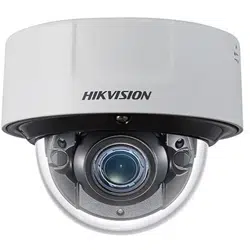Loading ...
Loading ...
Loading ...

iDS-2CD7xxG0-xxxxx Network Bullet Camera User Manual
UM iDS-2CD7xxG0-xxxxx 021021NA 22
• H.265+: H.265+ is an improved compression coding technology based on H.265. By enabling H.265+,
you can estimate the HDD consumption by its maximum average bitrate. Compared to H.265, H.265+
reduces storage by up to 50% with the same maximum bitrate in most scenes.
When H.265+ is enabled, Max. Average Bitrate is configurable. The device gives a recommended max.
average bitrate by default. You can adjust the parameter to a higher value if the video quality is less
satisfactory. Max. average bitrate should not be higher than max. bitrate.
With H.265+ enabled, Video Quality, I Frame Interval, Profile, and SVC are not configurable.
• I-Frame Interval: I-frame interval defines the number of frames between two I-frames.
In H.264 and H.265, an I-frame, or intra frame, is a self-contained frame that can be independently
decoded without any reference to other images. An I-frame consumes more bits than other frames.
Thus, video with more I-frames, in other words, smaller I-frame interval, generates more steady and
reliable data bits while requiring more storage space.
• SVC: Scalable Video Coding (SVC) is the name for the Annex G extension of the H.264 or H.265 video
compression standard.
The objective of the SVC standardization is to enable encoding of a high-quality video bitstream that
contains one or more subset bitstreams that can themselves be decoded with a complexity and
reconstruction quality similar to that achieved using the existing H.264 or H.265 design with the same
quantity of data as in the subset bitstream. The subset bitstream is derived by dropping packets from
the larger bitstream.
SVC enables forward compatibility for older hardware: the same bitstream can be consumed by basic
hardware, which can only decode a low-resolution subset, while more advanced hardware will be able
decode high quality video stream.
• MPEG4: MPEG4, refers to MPEG-4 Part 2, a video compression format developed by Moving Picture
Experts Group (MPEG).
• MJPEG: Motion JPEG (M-JPEG or MJPEG) is a video compression format in which intraframe coding
technology is used. Images in MJPEG format is compressed as individual JPEG images.
• Profile: This function means that under the same bitrate, the more complex the profile, the higher the
quality of the image, and the requirement for network bandwidth is also higher.
Smoothing
This refers to the smoothness of the stream. The higher the smoothing value, the better the stream
fluency, though the video quality may be lower. The lower the smoothing value, the higher the stream
quality, though it may appear not fluent.
ROI
ROI (Region of Interest) encoding helps to discriminate the ROI and background information in video
compression. The technology assigns more encoding resource to the region of interest, thus to increase
the quality of the ROI whereas the background information is less focused.
Loading ...
Loading ...
Loading ...
